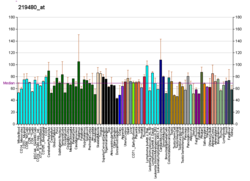SNAI1
Zinc finger protein SNAI1 (sometime referred to as Snail) is a protein that in humans is encoded by the SNAI1 gene. Snail is a family of transcription factors that promote the repression of the adhesion molecule E-cadherin to regulate epithelial to mesenchymal transition (EMT) during embryonic development.
The Drosophila embryonic protein SNAI1, commonly known as Snail, is a zinc finger transcriptional repressor which downregulates the expression of ectodermal genes within the mesoderm. The nuclear protein encoded by this gene is structurally similar to the Drosophila snail protein, and is also thought to be critical for mesoderm formation in the developing embryo. At least two variants of a similar processed pseudogene have been found on chromosome 2. SNAI1 zinc-fingers (ZF) binds to E-box, an E-cadherin promoter region, and represses the expression of the adhesion molecule, which induces the tightly bound epithelial cells to break loose from each other and migrate into the developing embryo to become mesenchymal cells. This process allows for the formation of the mesodermal layer in the developing embryo. Though SNAI1 is shown to repress expression of E-cadherin in epithelial cells, studies have shown homozygous mutant embryos are still able to form a mesodermal layer. However, the mesodermal layer present shows characteristics of epithelial cells and not mesenchymal cells (the mutant mesoderm cells exhibited a polarized state). Other studies show that mutation of specific ZFs contribute to a decrease in SNAI1 E-cadherin repression.
...
Wikipedia

